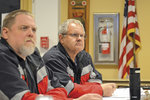

The Key Peninsula board of fire commissioners voted 4-0 to approve its 2023 budget for Fire District 16 at its November 22 meeting. The fifth commissioner had an excused absence.
The budget estimates $9,677,612 in spending during 2023, an increase of 2.8% over 2022. About 75% of that will go to paying for employee salaries, benefits and insurance, according to Fire Chief Nick Swinhart.
It was the first KPFD budget for Swinhart, who joined the department in May 2022 facing a budget shortfall and a public skeptical of the department’s spending $2.125 million on Key Center real estate at the end of 2021 for a possible new facility. (See accompanying article on page 12.)
“The biggest increases (in the 2023 budget) came from equipment purchases, like firefighter protective gear,” Swinhart said. “A lot of the training (expense) has been pushed off in the last couple of years and we’re trying to catch up on that. And there’s vehicle and facility maintenance we want to get on top of.”
The commissioners regularly fielded questions over the last year about the wisdom of the real estate deal and other spending, the necessity of a new facility, and whether “that kind of money,” as one resident put it, could have been put toward “saving lives.”
“We had a lot of discussions on this budget, probably more than we’ve had in a number of years,” Commission Chair Stan Moffett told KP News. “I think we prudently took a look at not spending everything that we had available to us and putting money into reserves … We really want to make sure that we have a good financial standing and make sure that we are taking care of our fiduciary responsibilities to the community.”
KPFD hired 12 career firefighters and paramedics over the last two years, adding eight new positions. That and other expenses required drawing down department reserves to a projected deficit of $200,000, said then-Executive Assistant Christina Bosch at the time, who left her job with the district in August.
Swinhart inherited that projected deficit in the 2022 budget, also attributed to increased overtime costs from Covid-related and other staff absences, including two career staff members put on paid administrative leave for over six and three months, respectively. Both were cleared of any wrongdoing by outside investigators and returned to duty in the spring of 2022.
But instead of a deficit, the department was on track to end the year about $185,000 in the black by press time, according to Swinhart.
“One major way we worked on closing that gap was working out an agreement with labor to change how and when we hire people back (after leave or injury) and overtime, which basically required lowering minimum staffing from seven to five,” he said.
The minimum number of personnel on shift was lowered to five in August and will remain there at least until January.
“It’s what we call a hard five; we don’t force overtime unless we drop below five, but we try to maintain seven,” Swinhart said. “Right now, we’ve got four vacancies; two long-term injuries and two people in paramedic school, so that definitely creates challenges day-to-day with staffing.”
Stations in Wauna, Home and Longbranch are all staffed 24/7, he said, and volunteers might staff Station 45, at the corner of State Route 302 and Wright-Bliss Road, early this year. Volunteers do not staff but currently respond out of Station 46 in Key Center.
Expanding services is a fixed cost, Swinhart said.
For example, staffing one station with one medic unit 24/7 can cost $1 million a year.
After buying a medic unit, which is between $200,000 to $300,000, “you always have to have at least two people on duty,” Swinhart said. “So, you’ve got two people per shift over three shifts; that is a minimum of six people that would be needed to staff that ambulance at that station. If you’re talking entry level, salary and benefits is over $100,000 per person. And you need at least eight people to make six per shift.”
That fixed cost only goes up with fuel, supplies, maintenance and repairs for the vehicle and the facility.
“What I’ve been trying to get across to the folks who’ve been asking about this recently at the meetings, if we want to staff a medic unit at Station 45, for instance, we’d have to hire those additional people or we’d have to pull them from somewhere else.”
KPFD receives insurance reimbursement for some ambulance rides, and netted about $560,000 from 1,039 transports in 2022 by November 30.
KPFD employs 36 line personnel including three administrative chiefs, and support and maintenance staff, serving a population of 18,000 spread out over 65 square miles. In 2021, the department responded to 2,524 calls, about 80% medical, which is typical across the fire service. That works out to an average of seven calls per day, or 2.33 per station. The average response time was 10 minutes.
UNDERWRITTEN BY THE FUND FOR NONPROFIT NEWS (NEWSMATCH) AT THE MIAMI FOUNDATION, THE ANGEL GUILD, ADVERTISERS, DONORS AND PEOPLE WHO SUPPORT INDEPENDENT, NONPROFIT LOCAL NEWS